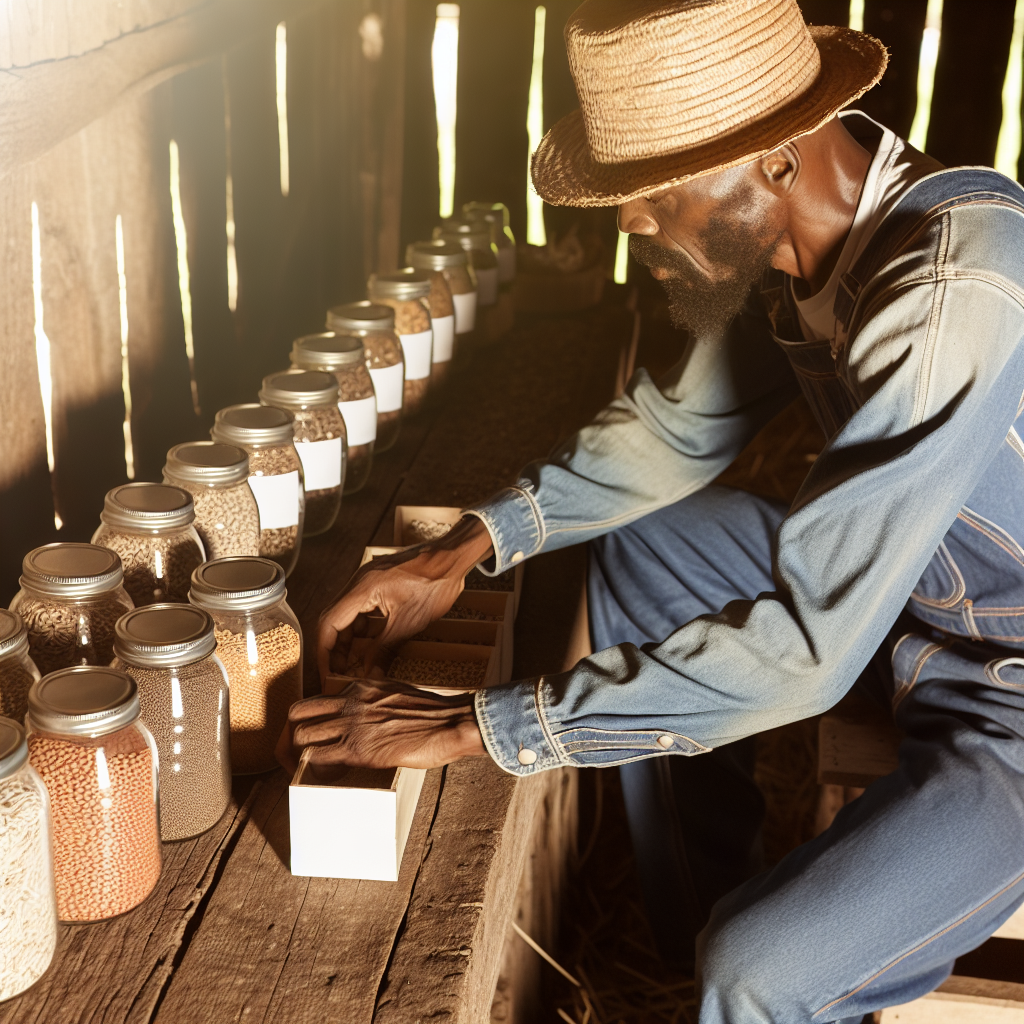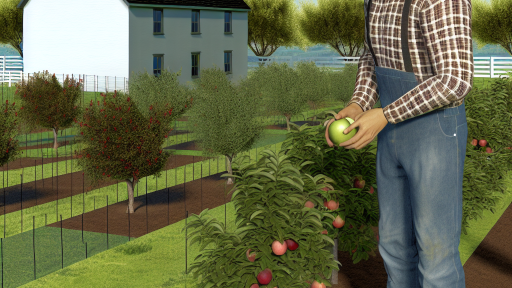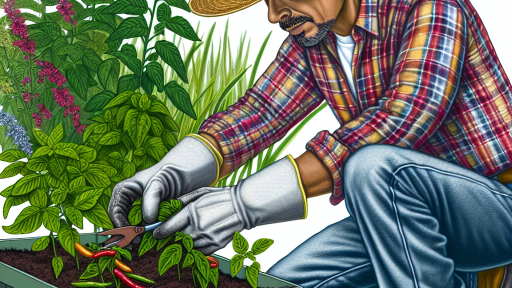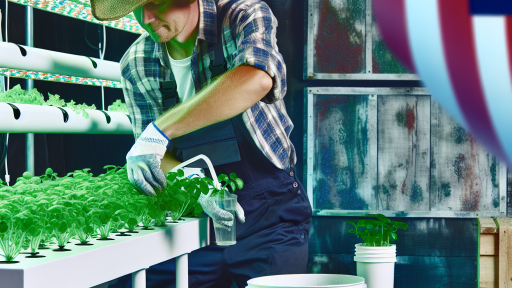Understanding the Importance of Seed Storage
Preservation of Genetic Diversity
Seed storage plays a vital role in preserving genetic diversity.
This diversity ensures crop resilience against pests and diseases.
Farmers benefit from diverse seeds during changing environmental conditions.
Enhancing Crop Yields
Proper seed storage directly affects crop yields.
Healthy seeds germinate more effectively than damaged ones.
This leads to stronger plants and ultimately higher production.
Cost Efficiency
Storing seeds saves farmers money in the long run.
They can avoid purchasing commercial seeds each year.
Using stored seeds reduces overall farming expenditure.
Time Management
Efficient seed storage can streamline planting processes.
Farmers can select and prepare seeds in advance.
Consequently, this saves valuable time during the planting season.
Environmental Sustainability
Seed storage contributes to environmental sustainability.
It decreases reliance on synthetic seeds and chemicals.
This practice promotes a more natural farming approach.
Transform Your Agribusiness
Unlock your farm's potential with expert advice tailored to your needs. Get actionable steps that drive real results.
Get StartedOptimal Environmental Conditions for Seed Storage
Temperature Control
Maintain a cool environment for optimal seed storage.
Temperature extremes can damage seeds.
Keep storage temperatures below 20°C.
Regularly check and adjust the temperature as needed.
Humidity Levels
Humidity control is critical for seed longevity.
Store seeds in a dry environment to prevent mold.
A humidity level between 20% and 40% is ideal.
Use desiccants to absorb excess moisture in storage.
Light Exposure
Limit light exposure to preserve seed viability.
Store seeds in opaque or dark containers.
Exposure to light can trigger germination prematurely.
Air Circulation
Good air circulation helps prevent moisture buildup.
Avoid tightly sealed containers unless they’re desiccated.
Consider using breathable bags for seed storage.
Pest Management
Protect stored seeds from pests and rodents.
Inspect storage areas regularly for signs of infestations.
Utilize traps or natural deterrents as needed.
Periodic Checks
Regularly inspect stored seeds for changes.
Look for signs of mold, moisture, or pests.
Take immediate action if any issues are discovered.
Types of Seed Containers and Their Benefits
Plastic Seed Bags
Plastic seed bags offer an affordable option for seed storage.
They are lightweight and easy to handle.
Additionally, they are moisture-resistant, keeping seeds dry.
However, prolonged exposure to sunlight can degrade them.
Showcase Your Farming Business
Publish your professional farming services profile on our blog for a one-time fee of $200 and reach a dedicated audience of farmers and agribusiness owners.
Publish Your ProfileGlass Jars
Glass jars provide an airtight seal for seed storage.
They protect seeds from moisture and pests effectively.
Make sure to store them in dark places to avoid light exposure.
Furthermore, they are reusable, promoting sustainability in farming.
Metal Containers
Metal containers offer superior durability for seed storage.
They are resistant to pests and moisture, making them safe options.
These containers often come with locking lids to ensure protection.
Additionally, they can be painted or decorated for a personal touch.
Vacuum-Sealed Bags
Vacuum-sealed bags remove air from the storage environment.
This method significantly extends seed viability through reduced oxidation.
They protect against moisture and pests as well.
However, they require a sealing machine for effective storage.
Wooden Boxes
Wooden boxes offer a natural aesthetic for seed storage.
They can be customized to fit various sizes and shapes.
Line them with plastic for moisture protection.
Moreover, they can double as decorative storage solutions.
Cardboard Seed Envelopes
Cardboard envelopes are an eco-friendly choice for storing seeds.
They allow seeds to breathe while protecting them from moisture.
However, invest in a cool, dry location for optimal storage conditions.
They are lightweight and easy to label as well.
Choosing the Right Container
Each type of container offers unique benefits for seed storage.
Consider factors like moisture resistance and pest control.
Reflect on the seed types you plan to store.
Ultimately, select the container that suits your farming needs best.
Delve into the Subject: DIY Seed Cleaning Methods For Farmers
The Role of Humidity in Seed Preservation
Understanding Humidity’s Impact
Humidity plays a critical role in seed preservation.
Excess moisture can lead to seed deterioration.
High humidity promotes mold and fungal growth.
On the other hand, too little humidity can cause seeds to dry out.
This condition may reduce seed viability.
Optimal Humidity Levels
Farmers should aim for a humidity level between 30% and 50%.
This range helps maintain seed longevity.
Monitoring humidity regularly can prevent issues.
Using hygrometers provides accurate readings.
Storage Techniques
Employ airtight containers to control humidity.
Vacuum sealing is an effective method.
Additionally, desiccants can absorb excess moisture.
Store seeds in cool, dark places to enhance preservation.
Identifying Humidity Problems
Be vigilant for signs of excessive moisture.
Check for discoloration or an unusual smell.
Showcase Your Farming Business
Publish your professional farming services profile on our blog for a one-time fee of $200 and reach a dedicated audience of farmers and agribusiness owners.
Publish Your ProfileMold growth indicates a serious humidity problem.
Act immediately if you identify these issues.
Maintaining Ideal Conditions
Invest in climate-controlled storage units.
This investment can prevent humidity-related damage.
Regularly inspect storage environments.
Proper ventilation also helps control humidity levels.
Find Out More: Seasonal Maintenance Tips For Container Gardens
Best Practices for Labeling and Organizing Seed Stocks
Importance of Proper Labeling
Proper labeling is crucial for managing seed stocks effectively.
It helps avoid confusion and ensures easy identification of seeds.
Additionally, accurate labels provide essential information about each seed type.
This process enhances tracking and inventory management.
Choosing the Right Labels
Select durable, weather-resistant labels for outdoor use.
Consider using waterproof markers to prevent fading.
Choose labels that can withstand various environmental conditions.
Vinyl labels often offer the best longevity in gardens and fields.
Organizing Seed Stocks
Organize seeds by type and planting season for efficiency.
Utilize designated storage bins for different categories.
Categorizing helps in retrieval during planting times.
Another option is to use color-coded bins for quick visual identification.
Creating an Inventory System
Developing an inventory system aids in tracking seed quantities.
Utilize spreadsheets to categorize seeds and record data.
Include details such as seed variety, quantity, and expiration date.
Regularly update the inventory following planting and harvesting.
Storing Labels Properly
Store labels in a dry, cool place to maintain their condition.
Avoid exposure to direct sunlight, which can cause fading.
Consider using a binder or portfolio for easy access.
Regularly check for wear and replace any damaged labels.
You Might Also Like: Strategies For Effective Seed Rotation
How to Test Seed Viability Before Planting
Importance of Testing Seed Viability
Testing seed viability is crucial for successful planting.
Viable seeds can significantly improve crop yields.
Understanding seed health helps farmers make informed decisions.
Methods to Test Seed Viability
There are several methods to test seed viability effectively.
The most common method is the germination test.
Another method is the float test which indicates density.
Germination Test
To perform a germination test, gather 10 to 20 seeds.
Choose a suitable growing medium such as paper towels.
Moisten the medium and place the seeds on it.
Cover the seeds to maintain humidity.
Check seeds after a week for germination rates.
Float Test
For the float test, fill a container with water.
Showcase Your Farming Business
Publish your professional farming services profile on our blog for a one-time fee of $200 and reach a dedicated audience of farmers and agribusiness owners.
Publish Your ProfileDrop the seeds into the water and wait a few minutes.
Viable seeds will sink while non-viable ones will float.
This method is quick and easy for bulk seed testing.
Factors Affecting Seed Viability
Several factors can influence seed viability and germination.
Storage conditions play a significant role in seed health.
Humidity and temperature should remain controlled.
Age of seeds also directly affects their viability.
Recommended Storage Practices
To maintain seed viability, store seeds in a cool, dry place.
Use airtight containers to avoid moisture absorption.
Label containers with planting dates for proper tracking.
Regularly check stored seeds for signs of damage.
See Related Content: Cost-Effective Aquaponics Setup Tips

Common Pests and Diseases That Affect Stored Seeds
Introduction to Seed Pests and Diseases
Stored seeds can be susceptible to various pests and diseases.
Identifying these threats is crucial for effective management.
Understanding the potential hazards helps in taking preventive measures.
Common Insect Pests
Insects are a significant threat to stored seeds.
Among them, weevil species are particularly notorious.
These pests can infest grains, causing severe losses.
Additionally, grain moths can damage seeds as well.
Regular monitoring will help keep these pests at bay.
Control Methods for Insect Pests
Implementing proper control methods is vital for seed preservation.
First, maintain cleanliness in storage areas.
Secondly, use approved insecticides when necessary.
Finally, employ traps to monitor pest activity.
Common Fungal Diseases
Fungal diseases can also pose risks to stored seeds.
Common fungi include Aspergillus and Fusarium species.
These pathogens can result in seed rot and reduced germination.
It’s essential to recognize signs of fungal infection early.
Preventive Measures Against Fungal Diseases
Preventing fungal diseases involves careful storage practices.
Firstly, ensure seeds are dry before storage.
Secondly, maintain proper ventilation in storage facilities.
Finally, use fungicides if necessary to protect your seed stock.
Preventing Rodent Infestations
Rodents can be another significant threat to stored seeds.
They have a knack for locating and consuming stored grain.
Therefore, it’s crucial to implement rodent control measures.
Effective Rodent Control Strategies
Rodent control starts with proper storage practices.
Seal entry points to storage facilities effectively.
Additionally, using traps can help reduce rodent populations.
Ultimately, a proactive approach is essential for prevention.
Seasonal Considerations for Seed Storage
Understanding Temperature Effects
Temperature significantly impacts seed longevity.
Showcase Your Farming Business
Publish your professional farming services profile on our blog for a one-time fee of $200 and reach a dedicated audience of farmers and agribusiness owners.
Publish Your ProfileWarm conditions can accelerate seed degradation.
Conversely, cooler environments help preserve seed viability.
Aim for a storage temperature between 32°F and 50°F.
Check storage areas regularly to ensure stability.
Humidity Control
Humidity levels should stay consistently low.
High humidity can lead to fungal growth on seeds.
Use a dehumidifier if moisture levels rise.
Ideal humidity levels range from 20% to 30%.
Store seeds in airtight containers to reduce moisture exposure.
Seasonal Adjustments
Adjust your storage techniques based on the season.
For example, more ventilation may be needed in summer.
Winter can dry out seeds, requiring careful monitoring.
Insulate storage areas against extreme temperature changes.
Regularly assess seed condition throughout the year.
Using Proper Containers
Select containers that provide adequate protection.
Glass jars and vacuum-sealed bags work well.
Avoid plastic bags that can trap moisture.
Label containers clearly for easy identification.
Keep a detailed inventory of all stored seeds.
Regular Inspections
Inspect seeds periodically for signs of spoilage.
Look for mold, discoloration, or unpleasant odors.
Remove any damaged seeds immediately to prevent spread.
Consider conducting a germination test every season.
This will help assess seed viability over time.
Innovative Technologies in Seed Preservation
Overview of Seed Preservation Technologies
Seed preservation has evolved tremendously in recent years.
Farmers now utilize a variety of innovative technologies.
These advancements ensure seed quality and viability over time.
As a result, farmers can maintain crop diversity and resilience.
Temperature and Humidity Control
Maintaining optimal temperature and humidity is crucial.
Advanced storage facilities now offer climate control features.
These systems keep seeds at ideal conditions throughout storage.
Consequently, seed germination rates improve dramatically.
Vacuum Packing and Sealing
Vacuum packing has become a popular method of seed preservation.
This technique reduces oxygen exposure to seeds.
It effectively minimizes the risk of spoilage and decay.
Moreover, vacuum-sealed packets prolong seed shelf life.
Biobanking Techniques
Biobanking involves the preservation of seeds for long-term storage.
This method relies on low-temperature storage environments.
It helps protect seeds from environmental conditions.
Additionally, biobanks often incorporate cryogenic freezing.
Showcase Your Farming Business
Publish your professional farming services profile on our blog for a one-time fee of $200 and reach a dedicated audience of farmers and agribusiness owners.
Publish Your ProfileThis technique significantly enhances seed longevity.
Digital Technologies in Seed Storage
Digital technologies are transforming seed storage practices.
Farmers can now track seed inventory using app-based systems.
These systems provide real-time data on seed conditions.
As a result, farmers can make informed decisions about usage.
Utilizing Genetic Analysis
Genetic analysis plays a significant role in seed preservation.
This technology allows farmers to assess seed viability.
Through genetic markers, farmers can select the best specimens.
This selection improves overall crop yield and disease resistance.
Preparing Seeds for Long-Term Storage: Steps and Tips
Understanding Seed Quality
High-quality seeds are essential for successful storage.
Start by inspecting seeds for signs of damage or disease.
Discard any seeds that appear weak or unhealthy.
Healthy seeds have better viability during storage.
Drying Your Seeds
Proper drying is crucial for long-term storage.
Ensure seeds are dry before packing them away.
Spread seeds in a single layer on a clean surface.
Allow them to air dry for several days in a cool area.
Use moisture-absorbing materials to help reduce humidity.
Selecting the Right Storage Containers
Choose appropriate containers to maintain seed integrity.
Glass jars with airtight lids are excellent options.
Consider using vacuum-sealed bags for extra protection.
Avoid plastic containers that can retain moisture.
Labeling Your Seeds
Effective labeling helps keep track of your seed varieties.
Include the type of seed and the date of storage.
Use durable, waterproof labels to ensure longevity.
Organize seeds by categories or planting times for easier access.
Storing in the Right Environment
The storage environment significantly affects seed viability.
Choose a cool, dark, and dry location for your seeds.
A basement or refrigerated space works well for many farmers.
Avoid areas with temperature fluctuations or high moisture.
Monitoring Seed Conditions
Regularly check stored seeds for signs of spoilage.
Inspect moisture levels and seed conditions every few months.
Replace any containers showing signs of damage or wear.
Maintain a log of stored seeds to track their condition.
Additional Resources
The Maine Farmer Saving the World’s Rarest Heirloom Seeds
Starting a Flower Farm on a Budget: Affordable Tips and Smart …




